The Blue Planetary Nebula is a planetary nebula located in the southern constellation Centaurus. Popularly known as the Southerner, it is the brightest planetary nebula in the far southern sky. It lies approximately 4,900 light-years away and has an apparent magnitude of 8.5. The nebula is catalogued as NGC 3918 in the New General Catalogue.
The Blue Planetary Nebula was discovered by the English astronomer Sir John Herschel in March 1834. With an apparent size between 8 and 10 arcseconds, it makes a good target for small telescopes. In long-exposure images, the nebula’s oval diameter appears considerably larger, about 19 or 20 arcseconds across.
NGC 3918 was named the Blue Planetary Nebula because of its rich blue colour and appearance, which is reminiscent of the images of the planet Neptune taken by the space probe Voyager 2 in 1989. In 10-inch telescopes, the nebula appears as a small bluish disk at low power.
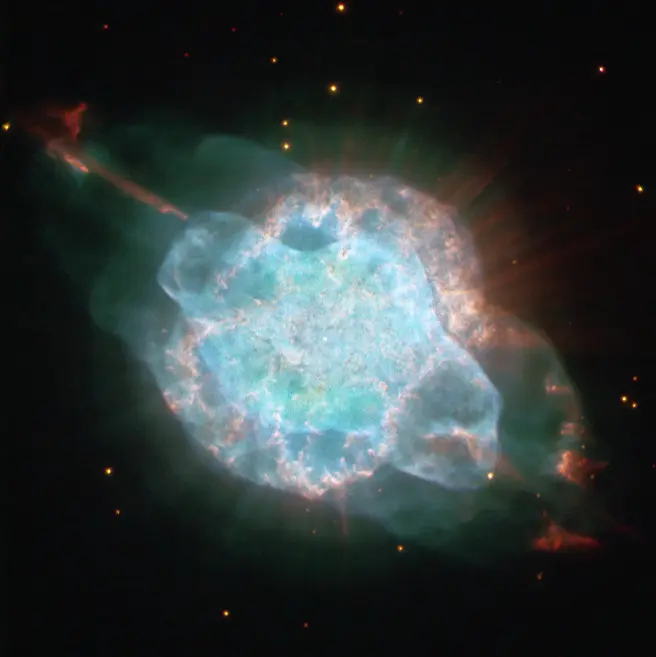
The Blue Planetary Nebula (NGC 3918), image: Judy Schmidt (CC BY 2.0)
The nebula was formed when a red giant star reached the end of its life and expelled its outer layers into space. The ejected material is illuminated by the intense ultraviolet light of the hot central stellar remnant which will eventually cool and fade. Planetary nebulae like NGC 3918 represent the final stages in the evolutionary cycle for most stars. The same fate awaits our own Sun in about 4-5 billion years.
The Blue Planetary Nebula expands at a rate of about 24 kilometres per second. It is approaching us at about 17 km/s.
The central star, catalogued as HD 102854, has an apparent magnitude of 14.6 and is well below the limit of unaided eye visibility. Even though it has a luminosity 6,000 times that of the Sun, the star is obscured by the light of the surrounding nebula.
The Blue Planetary Nebula was first imaged by NASA and ESA’s Hubble Space Telescope (HST) in 1998. The image revealed the shells of material expelled from the star. The shells form a spherical outer envelope and an elongated inner balloon, which is shaped by the fast stellar wind from the central star. The shells form an eye-like shape and appear like concentric rings around the hot progenitor star. They extend far beyond the nebula and will eventually dissipate into the surrounding space. The lifespan of planetary nebulae is only a few tens of thousands of years.
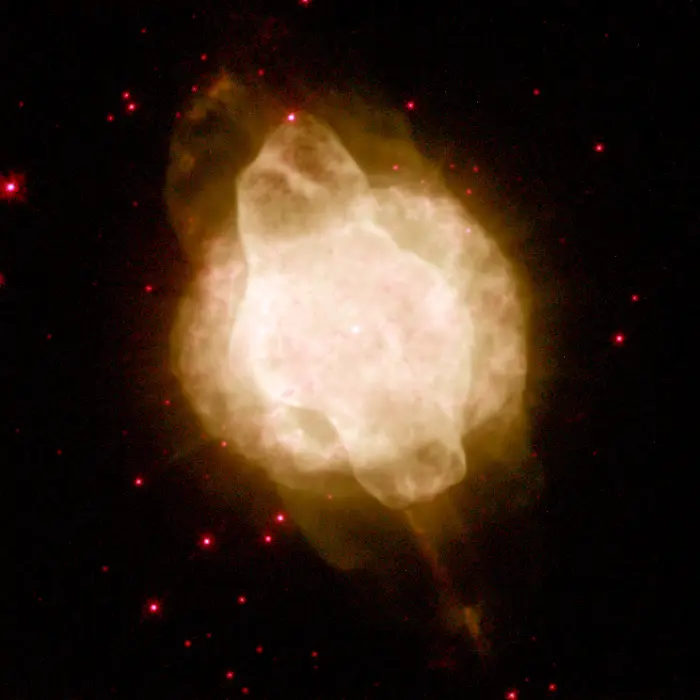
The Blue Planetary Nebula (NGC 3918 by the Hubble Space Telescope, image credit: Robert Rubin (NASA/ESA Ames Research Center), Reginald Dufour and Matt Browning (Rice University), Patrick Harrington (University of Maryland), and NASA/ESA
The Hubble telescope captured the Southerner again in 2010. The composite image of visible and near-infrared shots was taken with the Wide Field and Planetary Camera 2 and provided a better look into the details of the nebula.
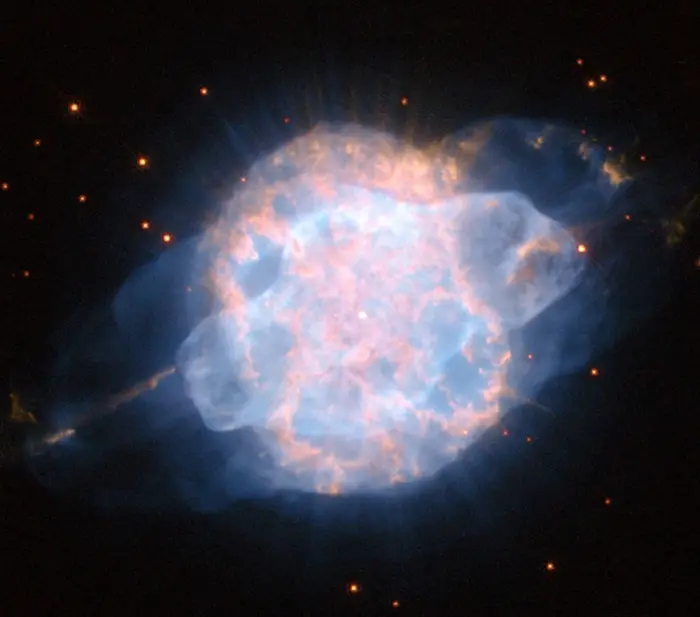
This dramatic image from the NASA/ESA Hubble Space Telescope shows the planetary nebula NGC 3918, a brilliant cloud of colourful gas in the constellation of Centaurus, around 4900 light-years from Earth. In the center of the cloud of gas, and completely dwarfed by the nebula, are the remnants of a red giant. During the final convulsive phase in the evolution of these stars, huge clouds of gas are ejected from the surface of the star before it emerges from its cocoon as a white dwarf. The intense ultraviolet radiation from the tiny remnant star then causes the surrounding gas to glow like a fluorescent sign. These extraordinary and colorful planetary nebulae are among the most dramatic sights in the night sky, and often have strange and irregular shapes, which are not yet fully explained. NGC 3918’s distinctive eye-like shape, with a bright inner shell of gas and a more diffuse outer shell that extends far from the nebula looks as if it could be the result of two separate ejections of gas. But this is in fact not the case: studies of the object suggest that they were formed at the same time, but are being blown from the star at different speeds. The powerful jets of gas emerging from the ends of the large structure are estimated to be shooting away from the star at speeds of up to 350,000 kilometers per hour. The image is a composite of visible and near-infrared snapshots taken with Hubble’s Wide Field Planetary Camera 2. The filters used were F658N, F814W, F555W and F502N, seen in red, orange, green and blue respectively. The image is about 20 arcseconds across. Image credit: NASA/the Hubble Space Telescope (CC BY 2.0)
Location
The Blue Planetary Nebula is relatively easy to find because it lies near the Southern Cross, one of the most recognizable asterisms in the far southern sky. The nebula appears very close to the imaginary line drawn through the Southern Cross, from Mimosa (Beta Crucis) to Imai (Delta Crucis) and extended by almost the same distance as that between the two stars. The nebula appears within an elongated triangle of fainter stars, about 2.5 degrees northwest of Imai.
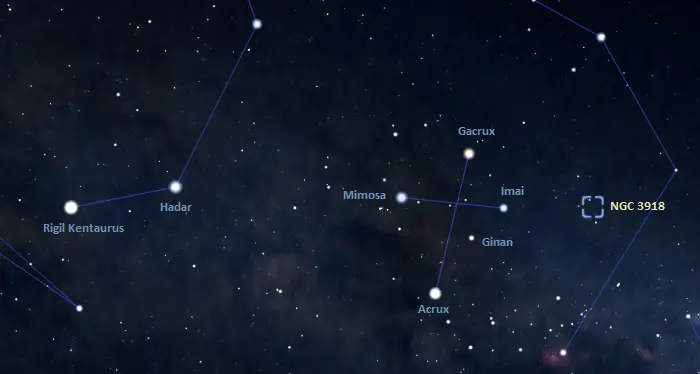
The location of the Blue Planetary Nebula, image: Stellarium
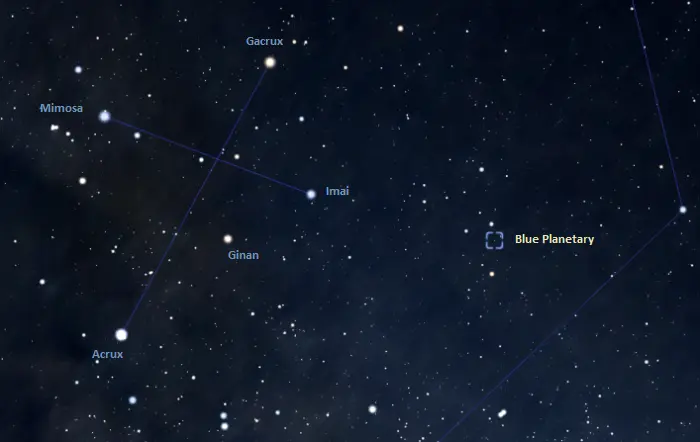
NGC 3918 location, image: Stellarium
The best time of the year to observe the Blue Planetary Nebula and other deep sky objects in Centaurus is during the month of May, when the constellation is high above the horizon in the evening.
The nebula never rises high above the horizon for observers in northern latitudes. It is invisible from locations north of the latitude 32° N.
Blue Planetary Nebula – NGC 3918
| Constellation | Centaurus |
| Right ascension | 11h 50m 17.7709504944s |
| Declination | −57° 10′ 57.017302428″ |
| Apparent magnitude | 8.5 |
| Apparent size | 0.26841834 x 0.26777998 arcminutes |
| Distance | 4,900 light-years (1.5 kiloparsecs) |
| Names and designations | Blue Planetary Nebula, the Southerner, NGC 3918, Hen 2-74, PK 294+4.1, ESO 170-1, ESO 170-13, Sa2-81, PN G294.6+04.7, AM 1147-565, ARO 514, VV 61, WRAY 16-101, TYC 8639-2315-1, HD 102854, Gaia DR2 5342260406474812416, Gaia DR3 5342260406474812416
|